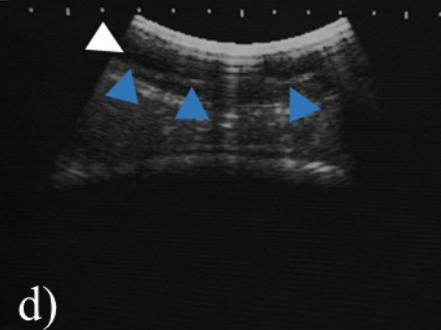Clinical evaluation of onlay double layer polyester mesh for repairing large umbilical hernias in buffalo calves
DOI:
https://doi.org/10.56825/bufbu.2024.4335580Keywords:
Bubalus bubalis, buffaloes, umbilical hernia, herniorrhaphy, polyester mesh , buffalo calves, abdominal surgeryAbstract
Umbilical hernias are a common issue in buffalo calves and can vary in their causes and treatment. While herniorrhaphy is a viable option for smaller hernias, larger hernias with diameters greater than three finger widths typically require the use of prosthetic materials for a successful and tension-free repair. This study aimed to evaluate the effectiveness of using a double layer polyester mesh to repair umbilical hernias in ten buffalo calves with hernial rings sizes ranging from ⩽11 cm in width. The study found that the use of a double layer of polyester mesh was successful in repairing hernias without any complications. Ultrasonographic examination was performed daily to assess the healing progress of the hernias. The use of a mesh allowed for tension-free repair and reduced the risk of recurrence. This technique may be a useful alternative for repairing larger umbilical hernias in buffalo calves. Overall, this study highlights the importance of using appropriate techniques for repairing umbilical hernias in buffalo calves, particularly when dealing with larger hernias. The use of prosthetic materials, such as a double-layer polyester mesh, can provide a successful and tension-free repair, reducing the risk of complications and recurrence.
Downloads
Metrics
References
Cobb, W.S., R.M. Peindl, M. Zerey, A.M. Carbonell and B.T. Heniford. 2009. Mesh terminology 101. Hernia, 13(1): 1-6. DOI: 10.1007/s10029-008-0428-3
Deeken, C.R. and S.P. Lake. 2017. Mechanical properties of the abdominal wall and biomaterials utilized for hernia repair. J. Mech. Behav. Biomed., 74: 411-427. DOI: 10.1016/j.jmbbm.2017.05.008
Doijode, V. and G. Beerappa. 2019. Hernioplasty for treatment of ventral hernia using nylon mesh in ruminants. Journal of Entomology and Zoology Studies, 7(3): 433-436.
Elango, S., S. Perumalsamy, K. Ramachandran and K. Vadodaria. 2017. Mesh materials and hernia repair. Biomedicine, 7(3): 16. DOI: 10.1051/bmdcn/2017070316
Herrmann, R., J. Utz, E. Rosenberger, K. Doll and O. Distl. 2001. Risk factors for congenital umbilical hernia in german fleckvieh. Vet. J., 162(3): 233-240. DOI: 10.1053/tvjl.2000.0567
Kassem, M.M., M.H. El-Kammar, A.S. Korittum and A.A. Abdel-Wahed. 2014. Using of polypropylene mesh for hernioplasty in calves. Alexandria Journal of Veterinary Sciences, 40(1): 112-117. DOI: 10.5455/ajvs.47290
Kiranjeet, S., M. Kant, V. Sangwan, A. Kumar, A. Arun and N. Saini. 2012. Hernioplasty using nylon mesh for massive ventral abdominal hernia in adult bovine. Indian J. Anim. Sci., 82(10): 1153-1155. DOI: 10.56093/ijans.v82i10.24284
Klinge, U. and B. Klosterhalfen. 2012. Modified classification of surgical meshes for hernia repair based on the analyses of 1,000 explanted meshes. Hernia, 16(3): 251-258. DOI: 10.1007/s10029-012-0913-6
Kumar, P.R., V.D. Prasad, M. Sreenu, N. Krishna and M. Raghunath. 2017. Surgical management of hernia - A clinical study of 18 buffalo calves. Intas Polivet, 18(2): 359-361.
Labik, K., P. Horin, L. Mikulas and J. Havrankova. 1977. Hereditarily conditioned cases of atresia ani hernia umbilicalis and syndactylia in cattle. Acta Vet. Brno, 46: 111-122.
Melkemichel, M., L. Stjärne, S. Bringman and B. Widhe. 2022. Onlay mesh repair for treatment of small umbilical hernias ≤ 2 cm in adults: A single-centre investigation. Hernia, 26(6): 1-7. DOI: 10.1007/s10029-021-02509-2
Moustafa, A.M. and M.A. Hamed. 2020. Comparison of primary incisional umbilical hernia closure in calves and buffalo calves with and without assistance for prosthetic mesh. Alexandria Journal for Veterinary Sciences, 67(2). DOI: 10.5455/ajvs.2028
Pereira, C. and S. Gururaj. 2023a. Onlay versus sublay mesh repair for incisional hernias: A systematic review. Cureus, 15(1): e34156. DOI: 10.7759/cureus.34156
R Core Team. 2020. R: A Language and Environment for Statistical Computing. R Foundation for Statistical Computing, Vienna, Austria.
Rafid, H.F., S.H. Al-Husseiny and A.N.A. Al-Ameer. 2018. Surgical treatment of hernia in cattle: A review. Al-Qadisiyah Journal of Veterinary Medicine Sciences, 17(2): 61-68. DOI: 10.29079/vol17iss2art506
Rahman, M.M., S. Sultana, M.Z. Ali and M.Z. Hassan 2017. Prevalence of umbilical hernia of calves and its risk factors at tangail sadar of bangladesh. Asian-Australasian Journal of Bioscience and Biotechnology, 2(2): 154-158. DOI: 10.3329/aajbb.v2i2.64381
Rastegarpour, A., M. Cheung, M. Vardhan, M.M. Ibrahim, C.E. Butler and H. Levinson. 2016. Surgical mesh for ventral incisional hernia repairs: Understanding mesh design. Plast. Surg.-Chir Plas, 24(1): 41-50. DOI: 10.4172/plastic-surgery.1000955
Reyes Avila, I.R., A. Rodriguez Maceo, Y. Ramirez Perez, A. Cuesta Guillen and Y. Gongora Pupo. 2013. Presence of hernias in buffalo calf and their answer to the surgical therapy. Redvet, 14(4).
Spadola, F., G. Costa, M. Morici, C. Interlandi, B. Nastasi and M. Musicò. 2017. Autologous prosthesis for the surgery of two simultaneous hernias in a calf. Large Anim. Rev., 23(5): 195-197.
Spadola, F., V.C. Neve, G.L. Costa, M. Musicò, A. Spadaro, F. Antoci, O. Cavallo and G. Cascone. 2022. Surgical approach and etiopathogenetic considerations to the umbilical tumefactions in cattle: Case review in twenty years (2000/2020). Vet. Anim. Sci., 17: 100258. DOI: 10.1016/j.vas.2022.100258
Sutradhar, B.C., M.F. Hossain, B.C. Das, G. Kim and M.A. Hossain. 2009. Comparison between open and closed methods of herniorrhaphy in calves affected with umbilical hernia. J. Vet. Sci., 10(4): 343-347. DOI: 10.4142/jvs.2009.10.4.343
Vilar, J.M., J.A. Corbera and G. Spinella. 2011. Double-layer mesh hernioplasty for repairing umbilical hernias in 10 goats. Turk. J. Vet. Anim. Sci., 35(2): 131-135. DOI: 10.3906/vet-1006-365
Vilar, J.M., F. Doreste, G. Spinella and S. Valentini. 2009. Double-layer mesh hernioplasty for repair of incisional hernias in 15 horses. J. Equine Vet. Sci., 29(3): 172-176. DOI: 10.1016/j.jevs.2009.02.001
Virtala, A.M., G.D. Mechor, Y.T. Gröhn and H.N. Erb. 1996. The effect of calfhood diseases on growth of female dairy calves during the first 3 months of life in new york state. J. Dairy Sci., 79(6): 1040-1049. DOI: 10.3168/jds.S0022-0302(96)76457-3









.png)








